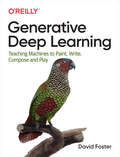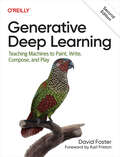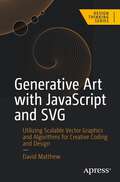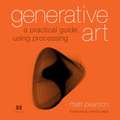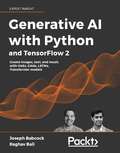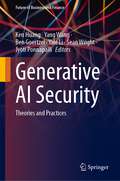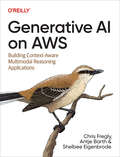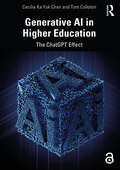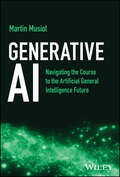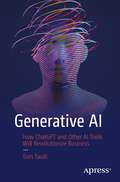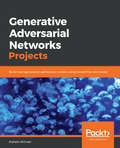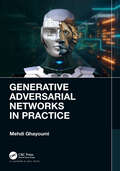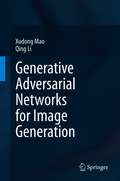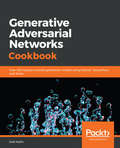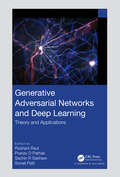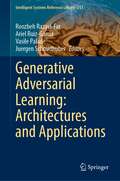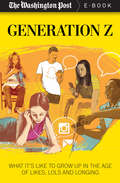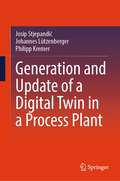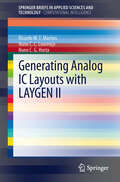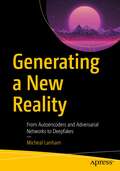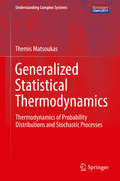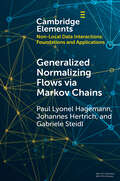- Table View
- List View
Generative Deep Learning: Teaching Machines to Paint, Write, Compose, and Play
by David FosterGenerative modeling is one of the hottest topics in AI. It’s now possible to teach a machine to excel at human endeavors such as painting, writing, and composing music. With this practical book, machine-learning engineers and data scientists will discover how to re-create some of the most impressive examples of generative deep learning models, such as variational autoencoders, generative adversarial networks (GANs), encoder-decoder models and world models.Author David Foster demonstrates the inner workings of each technique, starting with the basics of deep learning before advancing to some of the most cutting-edge algorithms in the field. Through tips and tricks, you’ll understand how to make your models learn more efficiently and become more creative. Discover how variational autoencoders can change facial expressions in photos; Build practical GAN examples from scratch, including CycleGAN for style transfer and MuseGAN for music generation; Create recurrent generative models for text generation and learn how to improve the models using attention; Understand how generative models can help agents to accomplish tasks within a reinforcement learning setting; Explore the architecture of the Transformer (BERT, GPT-2) and image generation models such as ProGAN and StyleGAN.
Generative Deep Learning: Teaching Machines To Paint, Write, Compose, And Play
by David FosterGenerative AI is the hottest topic in tech. This practical book teaches machine learning engineers and data scientists how to use TensorFlow and Keras to create impressive generative deep learning models from scratch, including variational autoencoders (VAEs), generative adversarial networks (GANs), Transformers, normalizing flows, energy-based models, and denoising diffusion models.The book starts with the basics of deep learning and progresses to cutting-edge architectures. Through tips and tricks, you'll understand how to make your models learn more efficiently and become more creative.Discover how VAEs can change facial expressions in photosTrain GANs to generate images based on your own datasetBuild diffusion models to produce new varieties of flowersTrain your own GPT for text generationLearn how large language models like ChatGPT are trainedExplore state-of-the-art architectures such as StyleGAN2 and ViT-VQGANCompose polyphonic music using Transformers and MuseGANUnderstand how generative world models can solve reinforcement learning tasksDive into multimodal models such as DALL.E 2, Imagen, and Stable DiffusionThis book also explores the future of generative AI and how individuals and companies can proactively begin to leverage this remarkable new technology to create competitive advantage.
Generative Art with JavaScript and SVG: Utilizing Scalable Vector Graphics and Algorithms for Creative Coding and Design (Design Thinking)
by David MatthewThis book introduces you to the exciting world of generative art and creative coding through the medium of JavaScript and Scalable Vector Graphics (SVG). Using tried and trusted techniques, you’ll tackle core topics such as randomness and regularity, noise and naturalistic variance, shape and path creation, filter effects, animation, and interactivity. In the process you’ll learn SvJs, a JavaScript library that closely mirrors the SVG spec and makes scripting SVG intuitive and enjoyable. You’ll also study the craft of generative art and its creative process, along with JavaScript fundamentals, using modern ES6+ syntax. Each chapter will build upon the previous one, and those completely new to programming will be given a primer to help them find their feet. Generative Art with JavaScript and SVG will take you on a fun journey, peppered with plenty of sketches throughout, designed not only to explain, but to inspire. You Will: • Structure and randomise compositions. • Understand the different types of randomness and their probability distributions. • Create organic variance with the SvJs Noise module. • Apply SVG filter effects in a generative fashion. • Explore different approaches to animating with SVG. • Make your compositions dynamic and interactive. WHO IS IT FOR: Web developers and designers and creative coders with an interest in digital and generative art as well as artists who are interested in learning to code with JavaScript.
Generative Art: A practical guide using Processing
by Matt PearsonSummaryGenerative Art presents both the technique and the beauty of algorithmic art. The book includes high-quality examples of generative art, along with the specific programmatic steps author and artist Matt Pearson followed to create each unique piece using the Processing programming language.About the TechnologyArtists have always explored new media, and computer-based artists are no exception. Generative art, a technique where the artist creates print or onscreen images by using computer algorithms, finds the artistic intersection of programming, computer graphics, and individual expression. The book includes a tutorial on Processing, an open source programming language and environment for people who want to create images, animations, and interactions.About the BookGenerative Art presents both the techniques and the beauty of algorithmic art. In it, you'll find dozens of high-quality examples of generative art, along with the specific steps the author followed to create each unique piece using the Processing programming language. The book includes concise tutorials for each of the technical components required to create the book's images, and it offers countless suggestions for how you can combine and reuse the various techniques to create your own works. Purchase of the print book comes with an offer of a free PDF, ePub, and Kindle eBook from Manning. Also available is all code from the book. What's InsideThe principles of algorithmic artA Processing language tutorialUsing organic, pseudo-random, emergent, and fractal processes=================================================Table of ContentsPart 1 Creative CodingGenerative Art: In Theory and PracticeProcessing: A Programming Language for ArtistsPart 2 Randomness and NoiseThe Wrong Way to Draw A LineThe Wrong Way to Draw a CircleAdding DimensionsPart 3 ComplexityEmergenceAutonomyFractals
Generative AI with Python and TensorFlow 2: Create images, text, and music with VAEs, GANs, LSTMs, GPT models and more
by Raghav Bali Joseph BabcockUnderstand the theory behind deep generative models and experiment with practical examplesKey FeaturesBuild a solid understanding of the inner workings of generative modelsExperiment with practical TensorFlow 2.x implementations of state-of-the-art modelsExplore a wide range of current and emerging use cases for deep generative AIBook DescriptionDeep generative models are powerful tools that rival human creative capabilities. In this book, you'll discover how these models emerged, from restricted Boltzmann machines and deep belief networks to VAEs, GANs, and beyond. You'll develop a foundational understanding of generative AI and learn how to implement models yourself in TensorFlow, supported by references to seminal and current research. After getting to grips with the fundamentals of deep neural networks, you'll set up a scalable code lab in the cloud and begin to explore the huge breadth of potential use cases for generative models. You'll look at Open AI's news generator, networks for style transfer and deepfakes, synergy with reinforcement learning, and more. As you progress, you'll recreate the code that makes these possible, piecing together TensorFlow layers, utility functions, and training loops to uncover links between the different modes of generation. By the end of this book, you will have acquired the knowledge to create and implement your own generative AI models.What you will learnImplement paired and unpaired style transfer with networks like StyleGANUse facial landmarks, autoencoders, and pix2pix GAN to create deepfakesBuild several text generation pipelines based on LSTMs, BERT, and GPT-2, learning how attention and transformers changed the NLP landscapeCompose music using hands-on LSTM models, simple GANs, and the intricate MuseGANTrain a deep learning agent to move through a simulated physical environmentDiscover emerging applications of generative AI, such as folding proteins and creating videos from images Who this book is forThis book will appeal to Python programmers, seasoned modelers, and machine learning engineers who are keen to learn about the creation and implementation of generative models. To make the most out of this book, you should have a basic familiarity with probability theory, linear algebra, and deep learning.
Generative AI Security: Theories and Practices (Future of Business and Finance)
by Ken Huang Yang Wang Ben Goertzel Yale Li Sean Wright Jyoti PonnapalliThis book explores the revolutionary intersection of Generative AI (GenAI) and cybersecurity. It presents a comprehensive guide that intertwines theories and practices, aiming to equip cybersecurity professionals, CISOs, AI researchers, developers, architects and college students with an understanding of GenAI’s profound impacts on cybersecurity. The scope of the book ranges from the foundations of GenAI, including underlying principles, advanced architectures, and cutting-edge research, to specific aspects of GenAI security such as data security, model security, application-level security, and the emerging fields of LLMOps and DevSecOps. It explores AI regulations around the globe, ethical considerations, the threat landscape, and privacy preservation. Further, it assesses the transformative potential of GenAI in reshaping the cybersecurity landscape, the ethical implications of using advanced models, and the innovative strategies required to secure GenAI applications. Lastly, the book presents an in-depth analysis of the security challenges and potential solutions specific to GenAI, and a forward-looking view of how it can redefine cybersecurity practices. By addressing these topics, it provides answers to questions on how to secure GenAI applications, as well as vital support with understanding and navigating the complex and ever-evolving regulatory environments, and how to build a resilient GenAI security program. The book offers actionable insights and hands-on resources for anyone engaged in the rapidly evolving world of GenAI and cybersecurity.
Generative AI on AWS
by Chris Fregly Antje Barth Shelbee EigenbrodeCompanies today are moving rapidly to integrate generative AI into their products and services. But there's a great deal of hype (and misunderstanding) about the impact and promise of this technology. With this book, Chris Fregly, Antje Barth, and Shelbee Eigenbrode from AWS help CTOs, ML practitioners, application developers, business analysts, data engineers, and data scientists find practical ways to use this exciting new technology.You'll learn the generative AI project life cycle including use case definition, model selection, model fine-tuning, retrieval-augmented generation, reinforcement learning from human feedback, and model quantization, optimization, and deployment. And you'll explore different types of models including large language models (LLMs) and multimodal models such as Stable Diffusion for generating images and Flamingo/IDEFICS for answering questions about images.Apply generative AI to your business use casesDetermine which generative AI models are best suited to your task Perform prompt engineering and in-context learningFine-tune generative AI models on your datasets with low-rank adaptation (LoRA)Align generative AI models to human values with reinforcement learning from human feedback (RLHF)Augment your model with retrieval-augmented generation (RAG)Explore libraries such as LangChain and ReAct to develop agents and actionsBuild generative AI applications with Amazon Bedrock
Generative AI in Higher Education: The ChatGPT Effect
by Cecilia Ka Chan Tom CollotonChan and Colloton’s book is one of the first to provide a comprehensive examination of the use and impact of ChatGPT and Generative AI (GenAI) in higher education.Since November 2022, every conversation in higher education has involved ChatGPT and its impact on all aspects of teaching and learning. The book explores the necessity of AI literacy tailored to professional contexts, assess the strengths and weaknesses of incorporating ChatGPT in curriculum design, and delve into the transformation of assessment methods in the GenAI era. The authors introduce the Six Assessment Redesign Pivotal Strategies (SARPS) and an AI Assessment Integration Framework, encouraging a learner-centric assessment model. The necessity for well-crafted AI educational policies is explored, as well as a blueprint for policy formulation in academic institutions. Technical enthusiasts are catered to with a deep dive into the mechanics behind GenAI, from the history of neural networks to the latest advances and applications of GenAI technologies.With an eye on the future of AI in education, this book will appeal to educators, students and scholars interested in the wider societal implications and the transformative role of GenAI in pedagogy and research.
Generative AI: Navigating the Course to the Artificial General Intelligence Future
by Martin MusiolAn engaging and essential discussion of generative artificial intelligence In Generative AI: Navigating the Course to the Artificial General Intelligence Future, celebrated author Martin Musiol—founder and CEO of generativeAI.net and GenAI Lead for Europe at Infosys—delivers an incisive and one-of-a-kind discussion of the current capabilities, future potential, and inner workings of generative artificial intelligence. In the book, you'll explore the short but eventful history of generative artificial intelligence, what it's achieved so far, and how it's likely to evolve in the future. You'll also get a peek at how emerging technologies are converging to create exciting new possibilities in the GenAI space. Musiol analyzes complex and foundational topics in generative AI, breaking them down into straightforward and easy-to-understand pieces. You'll also find: Bold predictions about the future emergence of Artificial General Intelligence via the merging of current AI models Fascinating explorations of the ethical implications of AI, its potential downsides, and the possible rewards Insightful commentary on Autonomous AI Agents and how AI assistants will become integral to daily life in professional and private contexts Perfect for anyone interested in the intersection of ethics, technology, business, and society—and for entrepreneurs looking to take advantage of this tech revolution—Generative AI offers an intuitive, comprehensive discussion of this fascinating new technology.
Generative AI: How ChatGPT and Other AI Tools Will Revolutionize Business
by Tom TaulliThis book will show how generative technology works and the drivers. It will also look at the applications – showing what various startupsand large companies are doing in the space. There will also be a look at the challenges and risk factors.During the past decade, companies have spent billions on AI. But the focus has been on applying the technology to predictions – which is known as analytical AI. It can mean that you receive TikTok videos that you cannot resist. Or analytical AI can fend against spam or fraud or forecast when a package will be delivered. While such things are beneficial, there is much more to AI. The next megatrend will be leveraging the technology to be creative. For example, you could take a book and an AI model will turn it into a movie – at very little cost. This is all part of generative AI. It’s still in the nascent stages but it is progressing quickly. Generative AI can already create engaging blog posts, social media messages, beautiful artwork and compelling videos.The potential for this technology is enormous. It will be useful for many categories like sales, marketing, legal, product design, code generation, and even pharmaceutical creation.What You Will LearnThe importance of understanding generative AIThe fundamentals of the technology, like the foundation and diffusion modelsHow generative AI apps workHow generative AI will impact various categories like the law, marketing/sales, gaming, product development, and code generation.The risks, downsides and challenges.Who This Book is ForProfessionals that do not have a technical background. Rather, the audience will be mostly those in Corporate America (such as managers) as well as people in tech startups, who will need an understanding of generative AI to evaluate the solutions.
Generative Adversarial Networks Projects: Build next-generation generative models using TensorFlow and Keras
by Kailash AhirwarThis book is intended for data scientists, machine learning developers, deep learning practitioners and AI enthusiasts who want a project guide to test their knowledge and expertise in building real-world GANs models. These full-fledged projects will help you master machine learning, and neural network principles. Basic understanding of machine learning and deep learning concepts will be handy. Hands-on experience in Tensorflow or Keras will be a plus point
Generative Adversarial Networks in Practice
by Mehdi GhayoumiThis book is an all-inclusive resource that provides a solid foundation on Generative Adversarial Networks (GAN) methodologies, their application to real-world projects, and their underlying mathematical and theoretical concepts. Key Features: • Guides you through the complex world of GANs, demystifying their intricacies • Accompanies your learning journey with real-world examples and practical applications • Navigates the theory behind GANs, presenting it in an accessible and comprehensive way • Simplifies the implementation of GANs using popular deep learning platforms • Introduces various GAN architectures, giving readers a broad view of their applications • Nurture your knowledge of AI with our comprehensive yet accessible content • Practice your skills with numerous case studies and coding examples • Reviews advanced GANs, such as DCGAN, cGAN, and CycleGAN, with clear explanations and practical examples • Adapts to both beginners and experienced practitioners, with content organized to cater to varying levels of familiarity with GANs • Connects the dots between GAN theory and practice, providing a well-rounded understanding of the subject • Takes you through GAN applications across different data types, highlighting their versatility • Inspires the reader to explore beyond this book, fostering an environment conducive to independent learning and research • Closes the gap between complex GAN methodologies and their practical implementation, allowing readers to directly apply their knowledge • Empowers you with the skills and knowledge needed to confidently use GANs in your projects Prepare to deep dive into the captivating realm of GANs and experience the power of AI like never before with Generative Adversarial Networks (GANs) in Practice. This book brings together the theory and practical aspects of GANs in a cohesive and accessible manner, making it an essential resource for both beginners and experienced practitioners.
Generative Adversarial Networks for Image Generation
by Xudong Mao Qing LiGenerative adversarial networks (GANs) were introduced by Ian Goodfellow and his co-authors including Yoshua Bengio in 2014, and were to referred by Yann Lecun (Facebook’s AI research director) as “the most interesting idea in the last 10 years in ML.” GANs’ potential is huge, because they can learn to mimic any distribution of data, which means they can be taught to create worlds similar to our own in any domain: images, music, speech, prose. They are robot artists in a sense, and their output is remarkable – poignant even. In 2018, Christie’s sold a portrait that had been generated by a GAN for $432,000. Although image generation has been challenging, GAN image generation has proved to be very successful and impressive. However, there are two remaining challenges for GAN image generation: the quality of the generated image and the training stability. This book first provides an overview of GANs, and then discusses the task of image generation and the details of GAN image generation. It also investigates a number of approaches to address the two remaining challenges for GAN image generation. Additionally, it explores three promising applications of GANs, including image-to-image translation, unsupervised domain adaptation and GANs for security. This book appeals to students and researchers who are interested in GANs, image generation and general machine learning and computer vision.
Generative Adversarial Networks Cookbook
by Josh KalinThis book is for data scientists, machine learning developers, and deep learning practitioners looking for a quick reference to tackle challenges and tasks in the GAN domain. Familiarity with machine learning concepts and working knowledge of Python programming language will help you get the most out of the book.
Generative Adversarial Networks and Deep Learning: Theory and Applications
by Roshani RautThis book explores how to use generative adversarial networks in a variety of applications and emphasises their substantial advancements over traditional generative models. This book's major goal is to concentrate on cutting-edge research in deep learning and generative adversarial networks, which includes creating new tools and methods for processing text, images, and audio. A Generative Adversarial Network (GAN) is a class of machine learning framework and is the next emerging network in deep learning applications. Generative Adversarial Networks(GANs) have the feasibility to build improved models, as they can generate the sample data as per application requirements. There are various applications of GAN in science and technology, including computer vision, security, multimedia and advertisements, image generation, image translation,text-to-images synthesis, video synthesis, generating high-resolution images, drug discovery, etc. Features: Presents a comprehensive guide on how to use GAN for images and videos. Includes case studies of Underwater Image Enhancement Using Generative Adversarial Network, Intrusion detection using GAN Highlights the inclusion of gaming effects using deep learning methods Examines the significant technological advancements in GAN and its real-world application. Discusses as GAN challenges and optimal solutions The book addresses scientific aspects for a wider audience such as junior and senior engineering, undergraduate and postgraduate students, researchers, and anyone interested in the trends development and opportunities in GAN and Deep Learning. The material in the book can serve as a reference in libraries, accreditation agencies, government agencies, and especially the academic institution of higher education intending to launch or reform their engineering curriculum
Generative Adversarial Learning: Architectures and Applications (Intelligent Systems Reference Library #217)
by Vasile Palade Roozbeh Razavi-Far Ariel Ruiz-Garcia Juergen SchmidhuberThis book provides a collection of recent research works addressing theoretical issues on improving the learning process and the generalization of GANs as well as state-of-the-art applications of GANs to various domains of real life. Adversarial learning fascinates the attention of machine learning communities across the world in recent years. Generative adversarial networks (GANs), as the main method of adversarial learning, achieve great success and popularity by exploiting a minimax learning concept, in which two networks compete with each other during the learning process. Their key capability is to generate new data and replicate available data distributions, which are needed in many practical applications, particularly in computer vision and signal processing. The book is intended for academics, practitioners, and research students in artificial intelligence looking to stay up to date with the latest advancements on GANs’ theoretical developments and their applications.
Generation Z: What It's Like to Grow up in the Age of Likes, LOLs and Longing
by The Washington PostAn in-depth profile of the digital native generation from the Pulitzer Prize-winning newspaper. For the generation after Millennials, technology has been the only way of life since birth. These children are the first group to have their formative moments chronicled on Facebook, to grow up surrounded by the ubiquity of smartphones, and most important, to navigate a social landscape ruled by the internet. With this lifestyle comes a host of issues that prior generations never dealt with, including cyberbullying, alienation from peers with greater access to technology, and an increasing vulnerability to online sexual predators. This series of articles from the Washington Post delves into the everyday lives of American kids and teenagers. With its exploration of the unique pressures and complications of living an online life (and most of life online), this collection is a must-read for anyone who cares about the future of Generation Z.
Generation Next
by Oli White**The bestselling debut novel from YouTube sensation Oli White. CONTAINS EXCLUSIVE BONUS CONTENT!**Things haven't been easy for Jack recently - life as a teenager has its ups and downs. But when he meets a new group of friends, who are every bit as geek as they are chic, his luck seems to be changing. Each of the group is talented and when they pool together to create Generation Next, an incredible new kind of social media platform, it's clear that they're on to something special.What if your Instagram account grew by hundreds of thousands of followers overnight, and big companies were fighting each other to offer you photoshoots? When GenNext suddenly goes viral, Jack and his friends are thrust into a crazy world of fame which is as terrifying as it is awesome. Because someone out there is determined to trip Jack up at every step. If he doesn't stop them, soon everyone he cares about - his friends, his family, and the girl he's falling for - will be in danger...
Generation Next
by Oli WhiteThe stunning debut novel from YouTube sensation Oli White. Includes an exclusive audiobook introduction read by Oli White.Things haven't been easy for Jack recently - life as a teenager has its ups and downs. But when he meets a new group of friends, who are every bit as geek as they are chic, his luck seems to be changing. Each of the group is talented and when they pool together to create Generation Next, an incredible new kind of social media platform, it's clear that they're on to something special. What if your Instagram account grew by hundreds of thousands of followers overnight, and big companies were fighting each other to offer you photoshoots? When GenNext suddenly goes viral, Jack and his friends are thrust into a crazy world of fame which is as terrifying as it is awesome. Because someone out there is determined to trip Jack up at every step. If he doesn't stop them, soon everyone he cares about - his friends, his family, and the girl he's falling for - will be in danger...(P)2016 Hodder & Stoughton
Generation Digital
by Kathryn C. MontgomeryChildren and teens today have integrated digital culture seamlessly into their lives. For most, using the Internet, playing videogames, downloading music onto an iPod, or multitasking with a cell phone is no more complicated than setting the toaster oven to "bake" or turning on the TV. In Generation Digital,media expert and activist Kathryn C. Montgomery examines the ways in which the new media landscape is changing the nature of childhood and adolescence and analyzes recent political debates that have shaped both policy and practice in digital culture. The media have pictured the so-called "digital generation" in contradictory ways: as bold trailblazers and innocent victims, as active creators of digital culture and passive targets of digital marketing. This, says Montgomery, reflects our ambivalent attitude toward both youth and technology. She charts a confluence of historical trends that made children and teens a particularly valuable target market during the early commercialization of the Internet and describes the consumer-group advocacy campaign that led to a law to protect children's privacy on the Internet. Montgomery recounts--as a participant and as a media scholar--the highly publicized battles over indecency and pornography on the Internet. She shows how digital marketing taps into teenagers' developmental needs and how three public service campaigns--about sexuality, smoking, and political involvement--borrowed their techniques from commercial digital marketers. Not all of today's techno-savvy youth are politically disaffected; Generation Digitalchronicles the ways that many have used the Internet as a political tool, mobilizing young voters in 2004 and waging battles with the music and media industries over control of cultural expression online. Montgomery's unique perspective as both advocate and analyst will help parents, politicians, and corporations take the necessary steps to create an open, diverse, equitable, and safe digital media culture for young people.
Generation and Update of a Digital Twin in a Process Plant
by Josip Stjepandić Johannes Lützenberger Philipp KremerThis book covers the most important subjects of digital twin in a process plant, including foundations, methods, achievements, and applications in a brownfield environment. Besides offering a variety of applications and procedural variants from research and industrial practice, this book also provides a comprehensive insight into holistic plant planning. It also discusses the challenges that currently exist in different application areas. This book would be of interest to industry professionals and researchers in industrial and manufacturing engineering.
Generating Analog IC Layouts with LAYGEN II
by Nuno C. Lourenço Ricardo M. Martins Nuno C.G. HortaThis book presents an innovative methodology for the automatic generation of analog integrated circuits (ICs) layout, based on template descriptions and on evolutionary computational techniques. A design automation tool, LAYGEN II was implemented to validate the proposed approach giving special emphasis to reusability of expert design knowledge and to efficiency on retargeting operations.
Generating a New Reality: From Autoencoders and Adversarial Networks to Deepfakes
by Micheal LanhamThe emergence of artificial intelligence (AI) has brought us to the precipice of a new age where we struggle to understand what is real, from advanced CGI in movies to even faking the news. AI that was developed to understand our reality is now being used to create its own reality. In this book we look at the many AI techniques capable of generating new realities. We start with the basics of deep learning. Then we move on to autoencoders and generative adversarial networks (GANs). We explore variations of GAN to generate content. The book ends with an in-depth look at the most popular generator projects.By the end of this book you will understand the AI techniques used to generate different forms of content. You will be able to use these techniques for your own amusement or professional career to both impress and educate others around you and give you the ability to transform your own reality into something new.What You Will LearnKnow the fundamentals of content generation from autoencoders to generative adversarial networks (GANs)Explore variations of GANUnderstand the basics of other forms of content generationUse advanced projects such as Faceswap, deepfakes, DeOldify, and StyleGAN2Who This Book Is ForMachine learning developers and AI enthusiasts who want to understand AI content generation techniques
Generalized Statistical Thermodynamics: Thermodynamics of Probability Distributions and Stochastic Processes (Understanding Complex Systems)
by Themis MatsoukasThis book gives the definitive mathematical answer to what thermodynamics really is: a variational calculus applied to probability distributions. Extending Gibbs's notion of ensemble, the Author imagines the ensemble of all possible probability distributions and assigns probabilities to them by selection rules that are fairly general. The calculus of the most probable distribution in the ensemble produces the entire network of mathematical relationships we recognize as thermodynamics. The first part of the book develops the theory for discrete and continuous distributions while the second part applies this thermodynamic calculus to problems in population balance theory and shows how the emergence of a giant component in aggregation, and the shattering transition in fragmentation may be treated as formal phase transitions. While the book is intended as a research monograph, the material is self-contained and the style sufficiently tutorial to be accessible for self-paced study by an advanced graduate student in such fields as physics, chemistry, and engineering.
Generalized Normalizing Flows via Markov Chains (Elements in Non-local Data Interactions: Foundations and Applications)
by Paul Lyonel Hagemann Johannes Hertrich Gabriele SteidlNormalizing flows, diffusion normalizing flows and variational autoencoders are powerful generative models. This Element provides a unified framework to handle these approaches via Markov chains. The authors consider stochastic normalizing flows as a pair of Markov chains fulfilling some properties, and show how many state-of-the-art models for data generation fit into this framework. Indeed numerical simulations show that including stochastic layers improves the expressivity of the network and allows for generating multimodal distributions from unimodal ones. The Markov chains point of view enables the coupling of both deterministic layers as invertible neural networks and stochastic layers as Metropolis-Hasting layers, Langevin layers, variational autoencoders and diffusion normalizing flows in a mathematically sound way. The authors' framework establishes a useful mathematical tool to combine the various approaches.
